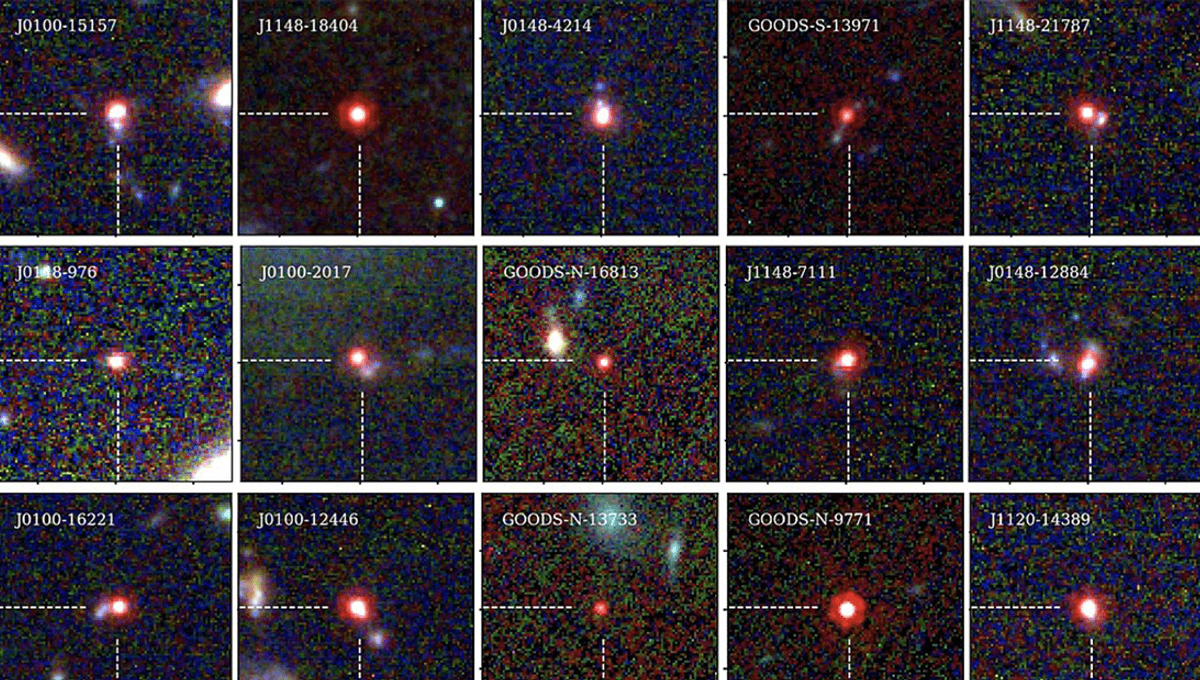
A new preprint study has taken a closer look at the “universe-breaking” Little Red Dot galaxies discovered in the early universe, potentially compounding the mystery surrounding them.
ADVERTISEMENT GO AD FREE
JWST has allowed astronomers to look back further into the past than any other infrared or optical telescope, seeing infrared light that was emitted by distant galaxies just 300 million years after the Big Bang. With the infrared telescope, we were hoping to learn more about the formation of galaxies, as well as clear up mysteries about how supermassive black holes became so large. But we have been thrown a few surprises as we look further back into the past.
One such surprise is the tiny, bright red points of light that appear to be dotted throughout the early universe, around 600-800 million years after its birth, which have come to be known as Little Red Dot galaxies. When they were first detected and analyzed, astronomers believed they could be massive galaxies. But this was at odds with how cosmological models expect galaxies to form – as small clouds of dust and stars that grow larger over long periods of time.
“The revelation that massive galaxy formation began extremely early in the history of the universe upends what many of us had thought was settled science,” Joel Leja, assistant professor of astronomy and astrophysics at Penn State, explained in a statement following early observations. “We’ve been informally calling these objects ‘universe breakers’ – and they have been living up to their name so far.”
Of course, seeing objects that could upend our models of galaxy formation, the team wanted to be sure of what they were seeing, and aimed to take spectrum images of these galaxies to get a better idea of the distance of the galaxies, what the galaxies are made of, and how massive they truly are. Following that analysis, they found these objects are indeed pretty weird, and in several ways.
Despite being only 600-800 million years old, the galaxies appear to be packed with ancient stars, aged hundreds of millions of years old. But there’s a bigger mystery to solve. That team estimated that the galaxies have surprisingly large supermassive black holes at their centers, between 100 and 1,000 times larger than Sagittarius A* at the center of the Milky Way. That’s far too big for the galaxy surrounding it, according to our current models. If the galaxy were compressed to the size of the Milky Way, the team said that the nearest star would be just outside our Solar System, and the supermassive black hole at the center would be just 26 light-years away from Earth, visible as a huge pillar of light.
“Normally supermassive black holes are paired with galaxies,” Leja said in a 2024 statement. “They grow up together and go through all their major life experiences together. But here, we have a fully formed adult black hole living inside of what should be a baby galaxy. That doesn’t really make sense, because these things should grow together, or at least that’s what we thought.”
ADVERTISEMENT GO AD FREE
In the recent universe, supermassive black holes make up about 0.01 percent of the mass of the galaxy overall. In these early universe red dot galaxies, according to a new study which has not yet been peer reviewed, the supermassive black holes appear to make up around 10 percent of the mass of the whole galaxies, placing them at the higher end of the “what on Earth is going on here?” scale.
“In the most extreme scenario, this would imply that the black holes are 1,000 times too heavy,” Jorryt Matthee, a scientist at the Institute of Science and Technology Austria and lead of the new team, told Space.com.
Cosmologists would, of course, like to know how these black holes became so large. There have been a number of theories, including mergers of black holes, and that the black holes grew through feeding. These early black holes, and others discovered by JWST, appear to be too large to be explained by these ideas, though it does appear possible that black holes can indulge themselves in some super-Eddington feeding, which could partly explain their gigantic mass.
ADVERTISEMENT GO AD FREE
Another idea is “direct collapse” or “heavy seed” black holes. Usually, to get a stellar mass black hole (in the current age of the universe), a star undergoes collapse. With heavy seed black holes the idea is that supermassive black holes would have started out at around 10,000 to 100,000 solar masses, through the direct gravitational collapse of gigantic gas clouds, without an intermediate stellar phase.
There are a few things that could make this scenario unlikely too. The gas cloud would need to collapse without fragmenting and forming clumps as it does so, though astronomers have suggested that this could be prevented if the cloud is heated by nearby young stars in pre-galactic gas disks, or if the gas cloud was moving at supersonic speeds in “flows” in the early universe, allowing it to grow for longer until the gravity was sufficient to start the cloud’s collapse into a seed black hole.
For now, we don’t really know how these Little Red Dot galaxies formed, and we will have to wait for more observations and more theoretical work. But that’s not necessarily a bad thing.
“Rather than saying this discovery is ‘troubling,’ I would say it is ‘promising’,” Matthee added, “as the large discrepancy suggests that we are about to learn something new.”
ADVERTISEMENT GO AD FREE
The new study has been submitted to The Astrophysical Journal but has not yet been through peer review. The preprint has been posted to arXiv.
Source Link: "We Are About To Learn Something New": Mystery Of "Little Red Dot" Galaxies Grows Weirder